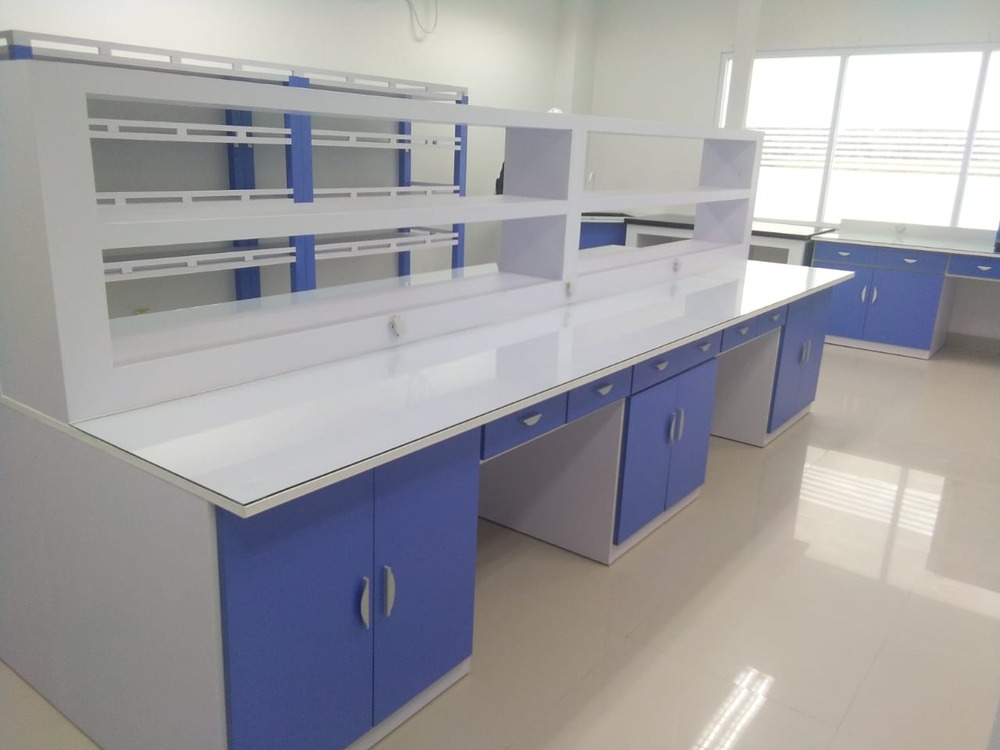Furniture Laboratory: Tailoring to Your Needs – Laboratories are dynamic environments where precision, functionality, and safety are paramount. When outfitting a laboratory, whether for educational, research, or industrial purposes, selecting the right furniture is crucial to ensure optimal workflow and compliance with safety standards. In this article, we explore the essential considerations for choosing laboratory furniture tailored to your specific needs.
Material Selection
The choice of materials for laboratory furniture significantly impacts its durability, resistance to chemicals, and overall performance. Common materials used include:
Stainless Steel: Known for its durability and resistance to corrosion, stainless steel is ideal for laboratory workbenches, cabinets, and storage units.
Epoxy Resin: This chemically inert material is suitable for laboratory countertops, providing resistance to harsh chemicals and heat.
Phenolic Resin: Offering similar chemical resistance to epoxy resin, phenolic resin is a cost-effective alternative for laboratory surfaces.
Powder-Coated Steel: Providing strength and resistance to corrosion, powder-coated steel is often used for frames and structural components of laboratory furniture.
Functional Design
Efficient laboratory furniture design is essential for maximizing space utilization and facilitating workflow. Consider the following factors:
Ergonomics: Adjustable features such as height-adjustable workbenches and chairs promote comfort and reduce the risk of musculoskeletal strain among laboratory personnel.
Modularity: Opt for modular furniture systems that allow for easy reconfiguration and adaptation to changing laboratory requirements.
Storage Solutions: Incorporate adequate storage options such as cabinets, drawers, and shelves to maintain organization and accessibility of laboratory supplies and equipment.
Integration of Utilities: Ensure provision for the integration of utilities such as gas, water, and electricity into laboratory furniture to support various experimental setups and instrumentation.
Compliance and Safety
Adherence to safety standards and regulations is non-negotiable in laboratory environments. When selecting laboratory furniture, prioritize features that promote safety:
Chemical Resistance: Choose materials that withstand exposure to corrosive chemicals commonly used in laboratory procedures.
Fire Retardancy: Opt for furniture with fire-resistant properties to mitigate the risk of fire hazards in the laboratory.
Stability and Load Capacity: Select furniture with robust construction capable of supporting the intended loads without compromising stability.
Easy Cleanability: Prioritize furniture surfaces that are easy to clean and disinfect to maintain a hygienic laboratory environment.
Budget Considerations
While quality and functionality are paramount, it’s essential to consider budget constraints when outfitting a laboratory. Balance cost-effectiveness with long-term durability and performance to ensure optimal value for your investment. Explore options for customizations and prioritize essential features that align with your budgetary limitations.
In conclusion, selecting the right laboratory furniture involves a thoughtful evaluation of material choices, functional design aspects, compliance with safety standards, and budget considerations. By prioritizing these factors and tailoring your choices to the specific needs of your laboratory, you can create a workspace that enhances productivity, safety, and efficiency for all laboratory operations.
What Is Laboratory Furniture?
Laboratory furniture plays a crucial role in ensuring the smooth functioning of scientific research and experimentation. From basic workbenches to specialized equipment, laboratory furniture encompasses a wide range of fixtures designed to meet the specific needs of scientists, researchers, and technicians. But what exactly constitutes laboratory furniture, and why is it essential in scientific settings?
Understanding Laboratory Furniture
Laboratory furniture refers to the various fixtures, equipment, and storage solutions used in scientific laboratories. These include:
- Workbenches and Tables: These are the primary surfaces where experiments, analyses, and other laboratory activities take place. They are typically made of materials such as stainless steel, epoxy resin, or chemical-resistant laminate to withstand harsh chemicals and rigorous usage.
- Storage Cabinets and Shelving: Laboratories require ample storage space for chemicals, reagents, glassware, and other equipment. Storage cabinets and shelving units are designed to organize and securely store these items while ensuring easy access for researchers.
- Fume Hoods and Safety Cabinets: Fume hoods are essential for containing and ventilating hazardous fumes, vapors, and airborne particles generated during experiments. Safety cabinets provide additional protection by storing flammable or corrosive substances in a secure, ventilated enclosure.
- Seating and Ergonomic Accessories: Comfortable seating is vital for researchers who spend extended periods working in the laboratory. Ergonomic chairs and accessories help prevent fatigue and musculoskeletal injuries, enhancing productivity and well-being.
- Specialized Equipment: Some laboratories may require specialized furniture or equipment tailored to specific research needs. This could include cleanroom benches, laminar flow workstations, or temperature-controlled incubators, among others.
Importance of Laboratory Furniture
The significance of laboratory furniture stems from its role in supporting scientific endeavors in the following ways:
- Safety and Compliance**: Properly designed laboratory furniture ensures the safety of researchers by minimizing exposure to hazardous substances and providing ergonomic work environments. Compliance with regulatory standards and guidelines is also facilitated through the use of certified laboratory furniture.
- Efficiency and Productivity: Well-designed laboratory layouts and furniture arrangements promote efficient workflow and organization, reducing time wasted on searching for equipment or reagents. This allows researchers to focus more on their experiments and analyses, leading to increased productivity.
- Durability and Longevity: Laboratory furniture is subjected to rigorous use and exposure to harsh chemicals, requiring robust construction and materials that can withstand such conditions. Durable furniture not only ensures longevity but also minimizes the need for frequent replacements, thereby reducing costs in the long run.
- Flexibility and Adaptability: Research needs may evolve over time, requiring laboratory spaces to be flexible and adaptable to accommodate changing requirements. Modular furniture systems allow for easy reconfiguration and expansion, enabling laboratories to stay aligned with evolving research goals.
- Organization and Cleanliness: Proper storage solutions and workspace organization contribute to a clean and clutter-free laboratory environment. This not only enhances safety and efficiency but also promotes a culture of cleanliness and orderliness among laboratory personnel.
In conclusion, furniture laboratorium plays a vital role in facilitating safe, efficient, and productive scientific research and experimentation. By providing the necessary infrastructure and support systems, well-designed laboratory furniture contributes to the advancement of knowledge and innovation across various scientific disciplines.



